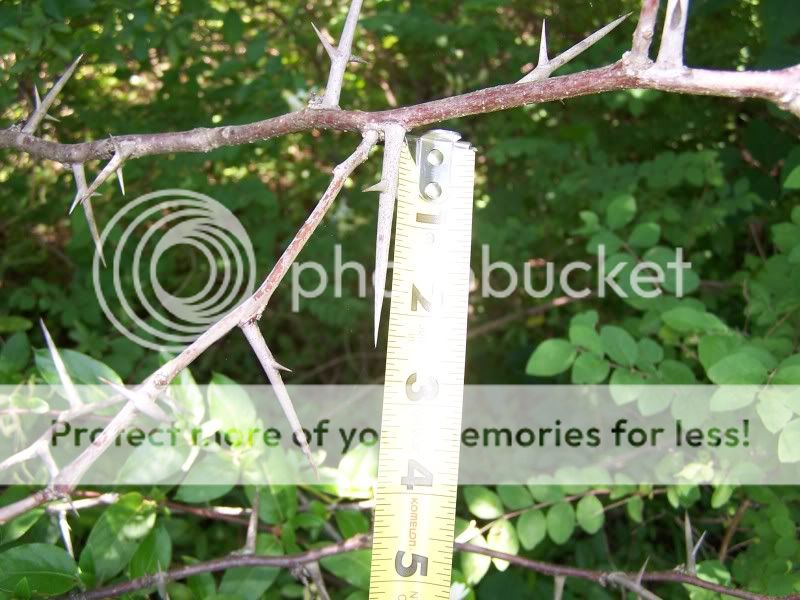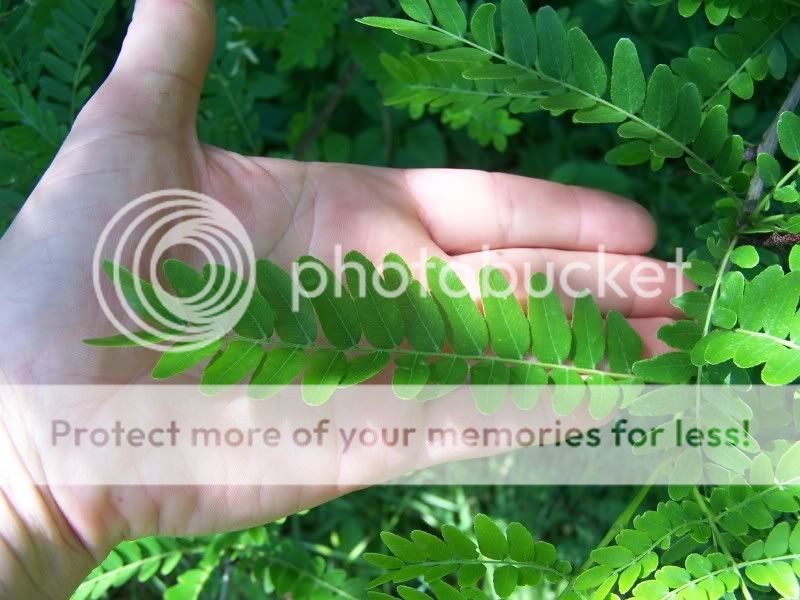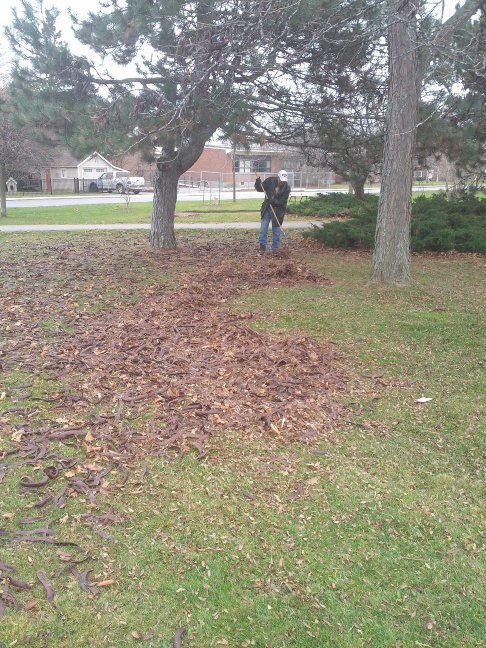
 2
2








 2
2




Honeylocust is a member of the leguminous family, but lacks the root nodules where bacteria symbiotically fix atmospheric nitrogen. For this reason honeylocust was thought not to fix nitrogen. Recent research at Yale University in the USA suggests that honeylocust does fix nitrogen directly in its roots without the formation of nodules. Further research now being conducted will most likely confirm the ability of honeylocust to fix nitrogen although at lower levels than nodulating leguminous species.
Principal - Terra Phoenix Design
http://TerraPhoenixDesign.com








 I found many many honey locusts....I think......how do I distinguish between honey locust and black locust....isn't black locust toxic??? anyway. I figured that was what was bringing the deer in but I was unaware that it had the potential to be utilized as a food source by humans. oh and...apparently the thorns are a bit of a nuisance when they come whipping back at you after being pushed by the tractor though so says my hsuband! yikes!
I found many many honey locusts....I think......how do I distinguish between honey locust and black locust....isn't black locust toxic??? anyway. I figured that was what was bringing the deer in but I was unaware that it had the potential to be utilized as a food source by humans. oh and...apparently the thorns are a bit of a nuisance when they come whipping back at you after being pushed by the tractor though so says my hsuband! yikes![img]http://i109.photobucket.com/albums/n52/havlik1/permie%20pics2/permiepotrait3pdd.jpg[/img]
"One cannot help an involuntary process. The point is not to disturb it. - Dr. Michel Odent




Gary




Principal - Terra Phoenix Design
http://TerraPhoenixDesign.com




Principal - Terra Phoenix Design
http://TerraPhoenixDesign.com
 2
2







[img]http://i109.photobucket.com/albums/n52/havlik1/permie%20pics2/permiepotrait3pdd.jpg[/img]
"One cannot help an involuntary process. The point is not to disturb it. - Dr. Michel Odent
 2
2




Principal - Terra Phoenix Design
http://TerraPhoenixDesign.com








paul wheaton wrote:
An enormous amount of information about black locust, with a focus on using it for animal feed:
http://www.lib.ncsu.edu/theses/available/etd-11242003-154755/unrestricted/etd.pdf
Gary








paul wheaton wrote:
Gary,
As you are reading that, if you come across any interesting points you can summarize, could you please share them here? Every time I look at that document, my mind tends to wander off.
Gary





[img]http://i109.photobucket.com/albums/n52/havlik1/permie%20pics2/permiepotrait3pdd.jpg[/img]
"One cannot help an involuntary process. The point is not to disturb it. - Dr. Michel Odent




 2
2




Brenda
Bloom where you are planted.
http://restfultrailsfoodforestgarden.blogspot.com/




Idle dreamer








Idle dreamer




 1
1




gary gregory wrote:Thanks for the info Paul and Dave. We have black locust and are planting a lot more of them for future use of the wood. We are going to double fence between paddocks with a 10 foot spacing for a variety of trees and shrubs and the honey locust sound like an excellent addition. If sheep can digest the pods, I would think goats could also. My neighbors all told me when I moved here, my trees were honey locust but further research proved they are black locust. I found this link to photos of honey locust and the page contains a link to photos of black locust.
http://www.pbase.com/hjsteed/foliage_locust
Lots of sites about black locust being poisonous. Our goats reach over the fence and occasionally eat the leaves and chew the bark and don't seem bothered by it. This occurs in areas where they have plenty of other food choices.
http://cal.vet.upenn.edu/projects/poison/plants/ppblack.htm




Idle dreamer
 2
2




Brenda Groth wrote:HOLY CRAP them are some nasty thorns.
"You must be the change you want to see in the world." "First they ignore you, then they laugh at you, then they fight you, then you win." --Mahatma Gandhi
"Preach the Gospel always, and if necessary, use words." --Francis of Assisi.
"Family farms work when the whole family works the farm." -- Adam Klaus




R Scott wrote:
Brenda Groth wrote:HOLY CRAP them are some nasty thorns.
And they are poisonous! You get stuck and don't take care of it right you may be losing whatever got stuck, or at least lose that muscle group and leave a nasty scar. Many old farmers in these parts had lost toes or fingers or forearm muscle to thorn infections--almost as many that lost them to the machinery.
The thorn is the first thing that comes out of the ground, too. A 4 inch sapling with three 3 inch spikes--natural caltrops. I lose tires to them every year, and several pairs of shoes. They will go through any shoe and many boots. Hard to spot in the grass, too.
"We're all just walking each other home." -Ram Dass
"Be a lamp, or a lifeboat, or a ladder."-Rumi
"It's all one song!" -Neil Young




 5
5




Pecan Media: food forestry and forest garden ebooks
Now available: The Native Persimmon (centennial edition)




Johnny Niamert wrote:Watch out for the dust.
I don't know what sneezing powder is made from, but I suggest honey locust pod dust.
 4
4




 4
4






The geographic range of honey-locust probably was extended by Indians who dried the legumes, ground the dried pulp, and used it as a sweetener and thickener, although the pulp also is reported to be irritating to the throat and somewhat toxic. Fermenting the pulp can make a potable or energy alcohol. Native Americans sometimes ate cooked seeds, they have also been roasted and used as a coffee substitute.
 4
4




 1
1




 1
1




 6
6









Pecan Media: food forestry and forest garden ebooks
Now available: The Native Persimmon (centennial edition)
 1
1




Lew Bivona wrote:As a basic test of whether I'd be able to eat the outer pod as well (if ground up according to the Carob/Honey Locust powder recipe I listed in my last post, above), I bit the pod and chewed a bit, trying to get out the "honey" that way. It worked, but I felt like there was a faint "spicy" feeling in the back of my throat (felt more like way on the back of my tongue).
Desert Harvesters wrote:Once you have found a tree that you want to pick from go ahead and TASTE one of the pods (watch out for the very hard seeds). If it tastes good to you, go ahead and pick from that tree. The flavor can vary widely from one tree to the next. If you are unfamiliar with the taste of good mesquite, it is a good idea to sample pods from several different trees..... The four undesirable characteristics you want to avoid in any pod are: bitter, chalky, or causing a burning sensation in back of the throat, or drying of the mouth. ... Keep in mind that no matter how you cook or process your mesquite pods, if you start with any undesirable characteristic in your pods, this will carry through into your end product.




Lew Bivona wrote:Hello All,
I just wanted to provide an update on my experiments with Honey Locust this season, hopefully it encourages other people to try next year and we can do some testing.
In searching in my area for good sources for pods, I found two. One was at my old alma mater, Rowan University here in South Jersey. I found those pods in late September, maybe very early October. From what I'd read about the cultivated "Hershey" variety, which is known for its large pods, about 16 pods could add up to a pound. The pods from this site were close to that large, with maybe 18 or so adding up to a pound. However, I only took 6 or 7 pods, since this was my first time actually trying them and I didn't want to take a ton if they weren't my bag. I thought these were delicious and the pulp tasted like an overripe (in a good way) sweet banana. I'd seen various reports about whether you can pick them ripe off the tree, or should wait until they fall, but I picked these off the tree and they were really tasty – even my wife, who's usually skeptical of my new plant adventures – liked them.
The other pods I found were actually on my current college campus, where I'm in grad school. I collected these much later, just at the very beginning of November. Because it was over a month later, all of these pods were collected from the ground. The pods were notably smaller than the earlier tree, and so there was less pulp, but it was still relatively the same in taste to me. As a basic test of whether I'd be able to eat the outer pod as well (if ground up according to the Carob/Honey Locust powder recipe I listed in my last post, above), I bit the pod and chewed a bit, trying to get out the "honey" that way. It worked, but I felt like there was a faint "spicy" feeling in the back of my throat (felt more like way on the back of my tongue). Didn't give it too much thought, though, since I'd incidentally chewed a little on the earlier pods and didn't have any sort of reaction. I collected a bunch of these pods to make into a "cocoa powder" as that recipe described.
I soaked, removed seeds from, roasted, and dryed the pods, then put them into my food processor to blend up into powder. Sieved it for the finest stuff. A better blender to make a finer powder would have been preferable. Still, the finished product was definitely fine enough to treat like a cocoa powder, and looked like this:

To test it out, I decided to try making my favorite cocoa-based treat: brownies! (or, in this case, "locusties?"). I followed a recipe for making carob-based brownies, and they came out nice and moist and sweet, texturally just like I like them. They came out looking more like blondies than brownies. Bottom line on these: If you're looking for something that will replace chocolate, or even carob (a replacement of a replacement), you're out of luck. They really tasted good and pretty unique to me, but not chocolatey by even the farthest stretch of the imagination (and I can stretch quite a bit). Here's a picture of the finished product:

Here things got a bit weird. I ate the first "brownie" and that familiar spice/tingling at the back of my tongue was definitely there, and because I'd eaten a large amount of the product, seemed more prominent. I also felt very slightly light-headed and it felt like my heart rate picked up while my breathing got slightly heavier. I'm totally food allergy free and also typically oblivious to things like that in my body, so the effect was definitely significant in order for me to notice. This effect only lasted for a couple of minutes, but is still enough to make me a bit weary. Here are what I imagine are possible explanations:
1. I have some sort of slight allergy to honey locust. This is possible, but it just doesn't seem likely given how much of the sweet stuff I've sucked out of the pods of the first tree I tried. I know in doing that I must have gotten some pieces of the pod, and they did not give me that weird tingly feeling.
2. Something changes in the composition of the pods between their early harvest time and their very late harvest time. After roasting I did notice a hole in one or two of the pods, as if a creature had gotten in and eaten some of the good stuff out. But I got that tingle even just form chewing the outside of the pod, so it doesn't seem like it would be the result of spoiling – plus, the sugars, which I'd expect to go sour way before the more durable outside pods, were still good.
3. The batch of pods I ultimately turned into my "cocoa powder" (the second ones, from my current campus) were from younger trees, and were also definitely thornless Honey Locust (Gleditsia inermis), whereas I am 95% sure the first batch Honey Locust was the thorned, tricanthos variety. I wish I'd paid closer attention to this, but I was just so excited to find a tree with such large pods! I plan to go back in the next week or two and double check myself here. If I'm right, this could mean tricanthos is suitable food, while inermis should probably be avoided. I plan to test this next year by testing both groups of trees, both in September and then both again near the end of their season. This should help determine if there is a difference between the two groups of trees and, if there is, whether this is due to timing or species differences.
Hopefully other folks will try this as well, so we can figure out the uses and limitations of this really cool tree!
Mandrake...takes on and holds the influence
of the devil more than other herbs because of its similarity
to a human. Whence, also, a person’s desires, whether good
or evil, are stirred up through it...
-Hildegard of Bingen, Physica
 2
2




Mandrake...takes on and holds the influence
of the devil more than other herbs because of its similarity
to a human. Whence, also, a person’s desires, whether good
or evil, are stirred up through it...
-Hildegard of Bingen, Physica
 3
3




Lew Bivona wrote:Hello All,
I just wanted to provide an update on my experiments with Honey Locust this season, hopefully it encourages other people to try next year and we can do some testing.
In searching in my area for good sources for pods, I found two. One was at my old alma mater, Rowan University here in South Jersey. I found those pods in late September, maybe very early October. From what I'd read about the cultivated "Hershey" variety, which is known for its large pods, about 16 pods could add up to a pound. The pods from this site were close to that large, with maybe 18 or so adding up to a pound. However, I only took 6 or 7 pods, since this was my first time actually trying them and I didn't want to take a ton if they weren't my bag. I thought these were delicious and the pulp tasted like an overripe (in a good way) sweet banana. I'd seen various reports about whether you can pick them ripe off the tree, or should wait until they fall, but I picked these off the tree and they were really tasty – even my wife, who's usually skeptical of my new plant adventures – liked them.
The other pods I found were actually on my current college campus, where I'm in grad school. I collected these much later, just at the very beginning of November. Because it was over a month later, all of these pods were collected from the ground. The pods were notably smaller than the earlier tree, and so there was less pulp, but it was still relatively the same in taste to me. As a basic test of whether I'd be able to eat the outer pod as well (if ground up according to the Carob/Honey Locust powder recipe I listed in my last post, above), I bit the pod and chewed a bit, trying to get out the "honey" that way. It worked, but I felt like there was a faint "spicy" feeling in the back of my throat (felt more like way on the back of my tongue). Didn't give it too much thought, though, since I'd incidentally chewed a little on the earlier pods and didn't have any sort of reaction. I collected a bunch of these pods to make into a "cocoa powder" as that recipe described.
I soaked, removed seeds from, roasted, and dryed the pods, then put them into my food processor to blend up into powder. Sieved it for the finest stuff. A better blender to make a finer powder would have been preferable. Still, the finished product was definitely fine enough to treat like a cocoa powder, and looked like this:

To test it out, I decided to try making my favorite cocoa-based treat: brownies! (or, in this case, "locusties?"). I followed a recipe for making carob-based brownies, and they came out nice and moist and sweet, texturally just like I like them. They came out looking more like blondies than brownies. Bottom line on these: If you're looking for something that will replace chocolate, or even carob (a replacement of a replacement), you're out of luck. They really tasted good and pretty unique to me, but not chocolatey by even the farthest stretch of the imagination (and I can stretch quite a bit). Here's a picture of the finished product:

Here things got a bit weird. I ate the first "brownie" and that familiar spice/tingling at the back of my tongue was definitely there, and because I'd eaten a large amount of the product, seemed more prominent. I also felt very slightly light-headed and it felt like my heart rate picked up while my breathing got slightly heavier. I'm totally food allergy free and also typically oblivious to things like that in my body, so the effect was definitely significant in order for me to notice. This effect only lasted for a couple of minutes, but is still enough to make me a bit weary. Here are what I imagine are possible explanations:
1. I have some sort of slight allergy to honey locust. This is possible, but it just doesn't seem likely given how much of the sweet stuff I've sucked out of the pods of the first tree I tried. I know in doing that I must have gotten some pieces of the pod, and they did not give me that weird tingly feeling.
2. Something changes in the composition of the pods between their early harvest time and their very late harvest time. After roasting I did notice a hole in one or two of the pods, as if a creature had gotten in and eaten some of the good stuff out. But I got that tingle even just form chewing the outside of the pod, so it doesn't seem like it would be the result of spoiling – plus, the sugars, which I'd expect to go sour way before the more durable outside pods, were still good.
3. The batch of pods I ultimately turned into my "cocoa powder" (the second ones, from my current campus) were from younger trees, and were also definitely thornless Honey Locust (Gleditsia inermis), whereas I am 95% sure the first batch Honey Locust was the thorned, tricanthos variety. I wish I'd paid closer attention to this, but I was just so excited to find a tree with such large pods! I plan to go back in the next week or two and double check myself here. If I'm right, this could mean tricanthos is suitable food, while inermis should probably be avoided. I plan to test this next year by testing both groups of trees, both in September and then both again near the end of their season. This should help determine if there is a difference between the two groups of trees and, if there is, whether this is due to timing or species differences.
Hopefully other folks will try this as well, so we can figure out the uses and limitations of this really cool tree!
Mandrake...takes on and holds the influence
of the devil more than other herbs because of its similarity
to a human. Whence, also, a person’s desires, whether good
or evil, are stirred up through it...
-Hildegard of Bingen, Physica
 1
1




if you wonder about my spelling🤔 i have dyslexia ore to say it in other words.
From my perspective every thing looks raigth. And if i try to find my misspellings, this makes it kind of complicated 
 3
3




R Scott wrote:
Brenda Groth wrote:HOLY CRAP them are some nasty thorns.
And they are poisonous! You get stuck and don't take care of it right you may be losing whatever got stuck, or at least lose that muscle group and leave a nasty scar. Many old farmers in these parts had lost toes or fingers or forearm muscle to thorn infections--almost as many that lost them to the machinery.
The thorn is the first thing that comes out of the ground, too. A 4 inch sapling with three 3 inch spikes--natural caltrops. I lose tires to them every year, and several pairs of shoes. They will go through any shoe and many boots. Hard to spot in the grass, too.
Jack Spirko,
The Survival Podcast







